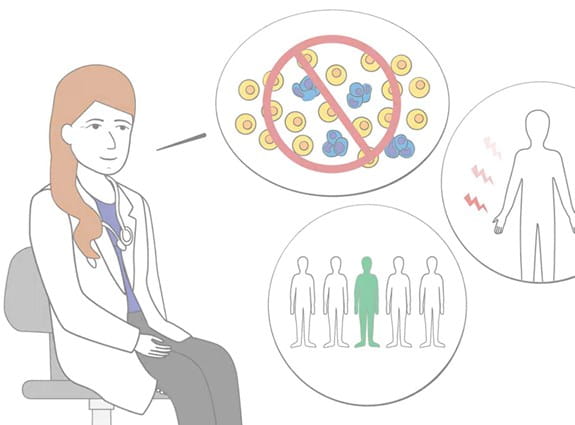Palliative care is more than end-of-life care
[The narrator, a man who has cancer, appears on screen. Beside him, 3 bubbles show common side effects of cancer and its treatment. The first bubble has a body outline with radiating lines representing pain. The second bubble has a person sleeping due to fatigue. And the third bubble has a body outline with lines at the stomach representing nausea and vomiting.]
Narrator: Soon after I was diagnosed with cancer, I had pain, fatigue and some nausea and vomiting from the cancer and its treatment.
[The focus zooms in on the narrator’s worried face. The scene ends.]
Narrator: I was also scared about my health and worried about the future.
[The narrator sits and talks with his oncologist in her office. The focus zooms in on the oncologist and 3 speech bubbles appear beside her. The first bubble has healthy cells and cancer cells in a red circle with a line through it, suggesting that palliative care doesn’t treat the cancer itself. The second bubble has a body outline with radiating lines to show pain, an example of a symptom that can be treated by palliative care. Finally, the third speech bubble has outlines of 5 people with the middle person coloured in, suggesting that people with cancer can find emotional, social and spiritual support from others through palliative care. The scene ends.]
Narrator: I talked to my oncologist about what I was feeling. She suggested palliative care to improve my quality of life and provide comfort. She said that palliative care doesn't treat the cancer itself. Instead, it prevents and treats symptoms related to cancer and cancer treatments, and provides emotional, social and spiritual support.
[Three older adults appear on screen.]
Narrator: I learned that palliative care is not only for people who are at the end of their life. That's just one part of it.
[Three younger people join the older adults on screen. Then they all fade out and are replaced by images of 3 palliative care settings: a home, a hospital and a palliative care centre. The scene ends.]
Narrator: Palliative care can also be used by anyone, at any age, even when they are receiving cancer treatments like chemotherapy and radiation. It can be provided at home, in a hospital or in a palliative care centre. Everyone's palliative care team will be different, depending on the needs, where you receive care and the resources available in your area.
[The screen is split into 4 sections, each with a different healthcare provider. The top-left section shows a home care nurse arriving at a house. The top-right section shows an oncologist. The bottom-left section shows a dietitian discussing food. The bottom-right section shows a social worker meeting with the main character and his family. The scene ends.]
Narrator: My team had a home care nurse who visited me, a doctor to help me manage the pain, a dietitian who gave me a special diet to reduce the effects of nausea and weight loss, and a social worker who suggested ways for me and my family to manage our stress.
[The narrator and his family go for a walk in a park. They look relaxed and happy. The scene ends.]
Narrator: I am so thankful I got support from a palliative care team early. They worked together to help me and my family cope with living with cancer.
[The healthcare team (home care nurse, oncologist, dietitian and social worker) appear on screen with the narrator. A binder labelled “Wellness Plan” appears in a bubble. The scene ends.]
Narrator: As I continue my treatment, my palliative care team makes sure I’m as comfortable as possible. They can also help me develop a wellness plan and an advance care plan.
[The narrator and his family appear on screen as a young family and then change into older versions of themselves to represent time passing. The children grow and the parents’ hair turns grey. The scene ends.]
Narrator: Like me, you may find that getting palliative care early in your cancer experience is a big help. In fact, research shows that palliative care can actually help people live longer.
[In the final scene of the video, the narrator stands and talks with his oncologist. They both smile.]
Narrator: Talk to your doctor about palliative care. The sooner you receive it, the better.
[The Canadian Cancer Society’s name, logo, phone number and website address appear in the centre of the screen. The Bank of Montreal (BMO) logo appears below as a proud sponsor of the Cancer Basics video series.]
Narrator: The Canadian Cancer Society can also help. Visit cancer.ca or call 1-888-939-3333.

